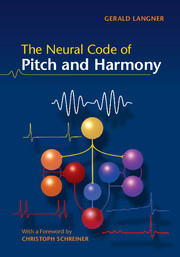Book contents
- Frontmatter
- Contents
- Preface
- Foreword
- 1 Historical aspects of harmony
- 2 Sound and periodicity
- 3 The discovery of the missing fundamental
- 4 The pitch puzzle
- 5 The auditory time constant
- 6 Pathways of hearing
- 7 Periodicity coding in the brainstem
- 8 Periodicity coding in the midbrain
- 9 Theories of periodicity coding
- 10 Periodotopy
- 11 The neural code of harmony
- 12 The oscillating brain
- References
- Index
9 - Theories of periodicity coding
Published online by Cambridge University Press: 05 May 2015
- Frontmatter
- Contents
- Preface
- Foreword
- 1 Historical aspects of harmony
- 2 Sound and periodicity
- 3 The discovery of the missing fundamental
- 4 The pitch puzzle
- 5 The auditory time constant
- 6 Pathways of hearing
- 7 Periodicity coding in the brainstem
- 8 Periodicity coding in the midbrain
- 9 Theories of periodicity coding
- 10 Periodotopy
- 11 The neural code of harmony
- 12 The oscillating brain
- References
- Index
Summary
Synchronization and harmony
In early 1976 I was standing chest-deep in the water of a flooded island, not far from the mouth of the Rio Negro, whose black water could still be seen alongside the white floods of the Amazon. The reason for this (for me, at least) unusual location was that my colleagues and I, accompanied by experts and fishermen from the Instituto Nacional de Pesquisas da Amazônia in Manaus, were fishing with nets and had to remove the water plants in which our prey – various species of electric fish–was hiding.
These fish are able to orientate and communicate in this dull environment using only their weak electric signals, and we wanted to study the amazing neuronal networks that make this possible. The result was worth all the trouble. One of the things we discovered later in the laboratory was that a certain electric fish (Sternarchorhamphus), which generates electrical signals with frequencies well above 1000 Hz, was able to couple its sinusoidal signals in phase with our electronic generators (Fig. 9.1; Langner and Scheich, 1978).
Another observation was that their phase-coupling could be one to one, but could also be in other harmonic relationships. This finding was in line with the near octave (1:2) relationship of the signals from males and females of another electric fish, Sternopygus macrurus, which was observed during courtship behaviour (Hopkins, 1974). Since our own haul produced a variety of species of electric fish that use different frequencies, we were able to see that Sternarchorhynchus also phase-coupled to signals of other species. Some of these discharged signals were several hundred Hertz below their own frequency and for a short time the two frequencies would stay in a harmonic relation, e.g. 2:3, 2:5 or 1:3 (mosquitoes use – for the same purpose – their wing-beat frequency; Warren et al., 2009; Gibson et al., 2010).
- Type
- Chapter
- Information
- The Neural Code of Pitch and Harmony , pp. 122 - 142Publisher: Cambridge University PressPrint publication year: 2015



